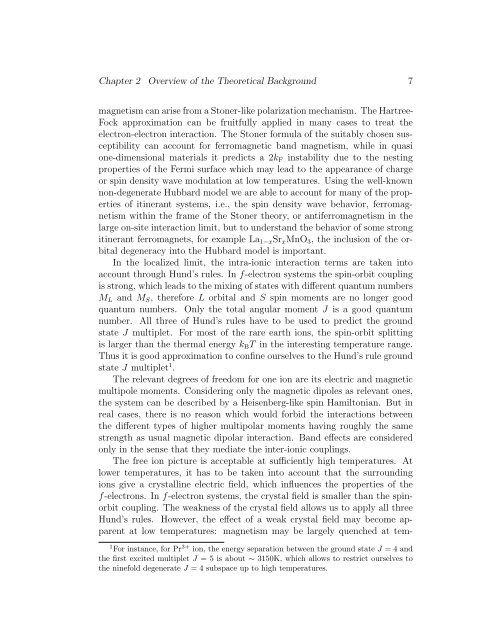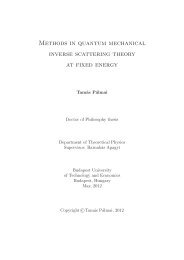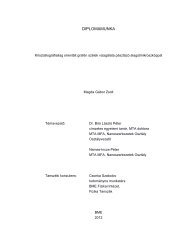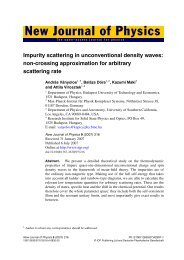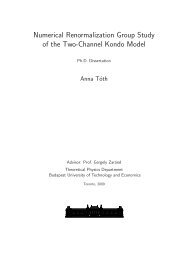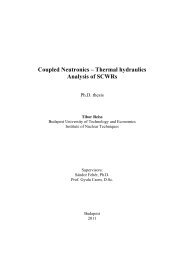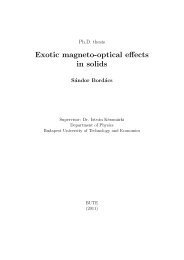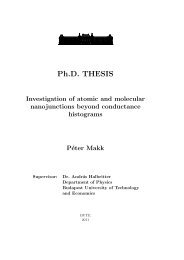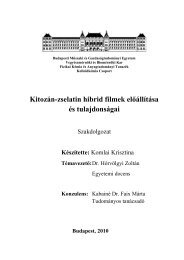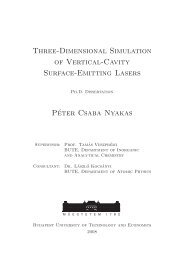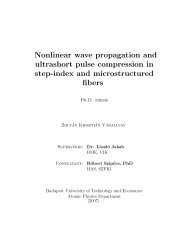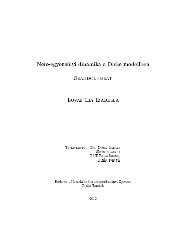Ph.D. THESIS Multipolar ordering in f-electron systems
Ph.D. THESIS Multipolar ordering in f-electron systems
Ph.D. THESIS Multipolar ordering in f-electron systems
Create successful ePaper yourself
Turn your PDF publications into a flip-book with our unique Google optimized e-Paper software.
Chapter 2 Overview of the Theoretical Background 7<br />
magnetism can arise from a Stoner-like polarization mechanism. The Hartree-<br />
Fock approximation can be fruitfully applied <strong>in</strong> many cases to treat the<br />
<strong>electron</strong>-<strong>electron</strong> <strong>in</strong>teraction. The Stoner formula of the suitably chosen susceptibility<br />
can account for ferromagnetic band magnetism, while <strong>in</strong> quasi<br />
one-dimensional materials it predicts a 2k F <strong>in</strong>stability due to the nest<strong>in</strong>g<br />
properties of the Fermi surface which may lead to the appearance of charge<br />
or sp<strong>in</strong> density wave modulation at low temperatures. Us<strong>in</strong>g the well-known<br />
non-degenerate Hubbard model we are able to account for many of the properties<br />
of it<strong>in</strong>erant <strong>systems</strong>, i.e., the sp<strong>in</strong> density wave behavior, ferromagnetism<br />
with<strong>in</strong> the frame of the Stoner theory, or antiferromagnetism <strong>in</strong> the<br />
large on-site <strong>in</strong>teraction limit, but to understand the behavior of some strong<br />
it<strong>in</strong>erant ferromagnets, for example La 1−x Sr x MnO 3 , the <strong>in</strong>clusion of the orbital<br />
degeneracy <strong>in</strong>to the Hubbard model is important.<br />
In the localized limit, the <strong>in</strong>tra-ionic <strong>in</strong>teraction terms are taken <strong>in</strong>to<br />
account through Hund’s rules. In f-<strong>electron</strong> <strong>systems</strong> the sp<strong>in</strong>-orbit coupl<strong>in</strong>g<br />
is strong, which leads to the mix<strong>in</strong>g of states with different quantum numbers<br />
M L and M S , therefore L orbital and S sp<strong>in</strong> moments are no longer good<br />
quantum numbers. Only the total angular moment J is a good quantum<br />
number. All three of Hund’s rules have to be used to predict the ground<br />
state J multiplet. For most of the rare earth ions, the sp<strong>in</strong>-orbit splitt<strong>in</strong>g<br />
is larger than the thermal energy k B T <strong>in</strong> the <strong>in</strong>terest<strong>in</strong>g temperature range.<br />
Thus it is good approximation to conf<strong>in</strong>e ourselves to the Hund’s rule ground<br />
state J multiplet 1 .<br />
The relevant degrees of freedom for one ion are its electric and magnetic<br />
multipole moments. Consider<strong>in</strong>g only the magnetic dipoles as relevant ones,<br />
the system can be described by a Heisenberg-like sp<strong>in</strong> Hamiltonian. But <strong>in</strong><br />
real cases, there is no reason which would forbid the <strong>in</strong>teractions between<br />
the different types of higher multipolar moments hav<strong>in</strong>g roughly the same<br />
strength as usual magnetic dipolar <strong>in</strong>teraction. Band effects are considered<br />
only <strong>in</strong> the sense that they mediate the <strong>in</strong>ter-ionic coupl<strong>in</strong>gs.<br />
The free ion picture is acceptable at sufficiently high temperatures. At<br />
lower temperatures, it has to be taken <strong>in</strong>to account that the surround<strong>in</strong>g<br />
ions give a crystall<strong>in</strong>e electric field, which <strong>in</strong>fluences the properties of the<br />
f-<strong>electron</strong>s. In f-<strong>electron</strong> <strong>systems</strong>, the crystal field is smaller than the sp<strong>in</strong>orbit<br />
coupl<strong>in</strong>g. The weakness of the crystal field allows us to apply all three<br />
Hund’s rules. However, the effect of a weak crystal field may become apparent<br />
at low temperatures: magnetism may be largely quenched at tem-<br />
1 For <strong>in</strong>stance, for Pr 3+ ion, the energy separation between the ground state J = 4 and<br />
the first excited multiplet J = 5 is about ∼ 3150K, which allows to restrict ourselves to<br />
the n<strong>in</strong>efold degenerate J = 4 subspace up to high temperatures.


